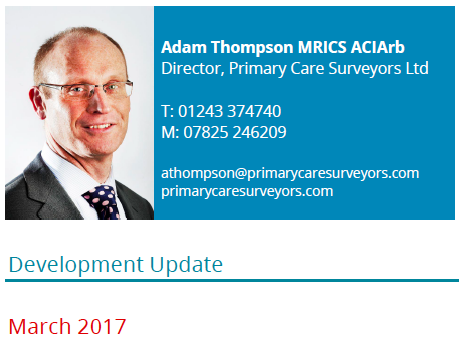
It is encouraging to note that there is much more activity now taking place with proposed development of new medical centres.
This has come about with the implementation of the Estates and Technology Transformation Fund (ETTF) for which the new medical centres need to be up and running by 31 March 2019. With construction typically taking the best part of 12 months, this means that all the pre-construction work is now taking place, notably to include the detailed design and specification and also to obtain planning consent. However, with many of the approved schemes, the initial approval is only in principle, with practices now needing to make further submissions to the NHS by way of detailed business cases. This is certainly eating into the limited time available if these new medical centres are to be open within two years.
Some GP practices have been quite surprised that an additional business case is required when to secure ETTF funding, many of them put in very detailed and comprehensive Project Initiation Documents (PIDs). Given that much of the information from the PID can be used to populate the business case, this does seem to be a slight case of process frustrating delivery.
The extent of ETTF funding is generally limited and was never going to deliver the massive overhaul of primary care infrastructure that is required for the wholesale re-provision of services needed, not least to meet the objectives of the Sustainability and Transformation Plans (STP). However, there is clear strategic desire for some of these proposed developments to be delivered, and it is most encouraging where there is such constructive engagement with the NHS to ensure delivery of these new premises.
One of the key objectives of the STP is for NHS organisations to demonstrate how they will achieve and maintain financial balance, which will essentially focus on the re-provision of services since this is by far the most significant part of NHS expenditure, with property quite correctly being a small part. Property is merely there as a resource to accommodate the delivery of health service provision.
With many organisations including GP practices now looking more to the future, but many not having applied for ETTF funding, questions about new premises are now being raised. The timetable for these more recent enquiries is based on delivery of medical services beyond 2019. Details of premises funding beyond the ETTF are not known and it is quite likely there will be no specific initiative directed at property resources.
The focus of re-provision from 2019 onwards is likely to be down to CCG budgets, with individual CCGs having responsibility for how much they wish to spend on new premises. This in turn will be led by how services are to be restructured and whether the existing infrastructure is sufficient for the provision of services. In many instances, the existing infrastructure is not adequate and is frustrating the transformation in service, to the brief that is important in order to achieve and maintain financial balance into the future.
From a delivery perspective, the demand for new medical centres will only be met if the level of rent for new premises is sufficient to ensure the new medical centre is viable. In many instances the District Valuer has been trying to maintain rent levels no higher than those approved at the previous height of the property market in 2009. Since then, construction costs have increased significantly, as have land values. The sustainability criteria, such as BREEAM, is further increasing the cost of developing new medical centres. Whilst increasing costs could be covered to a point by virtue of historic low interest rates (which in turn have driven down investment yields), cost inflation has reached such levels that new medical centres will only be viable if rents are agreed at a new, higher level, too.
Where CCGs are keen for new medical centres to be delivered in order to facilitate the re-provision of healthcare services, the additional cost of new premises is relatively insignificant compared to the quantum of expected savings in healthcare services. The main driver is now transforming how healthcare services can be delivered more effectively.
The other issue is that of lease terms for new premises. Practices are sometimes reluctant to agree to sign a lease for, say, 20-25 year terms. Whilst many developers are not averse to agreeing to grant a shorter lease, the development will only viable if a higher level of rent can be achieved in order to allow for the cost of development being recovered over a shorter period of time.
From my point of view, it is interesting that the day-to-day pressures on primary care are leading to there being more focus on the required infrastructure for the provision of services into the future, with the ETTF being seen as a short-term limited initiative. Healthcare demand will continue unabated and the need to re-provide services is greater than any short-term initiative. Greater strategic planning is required.

